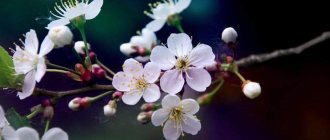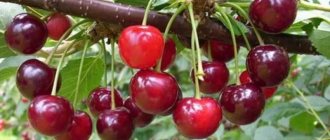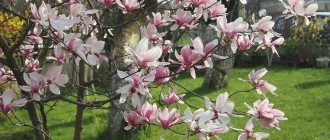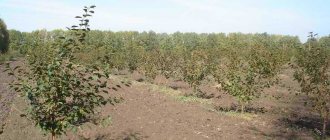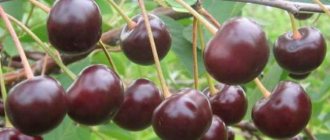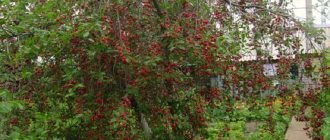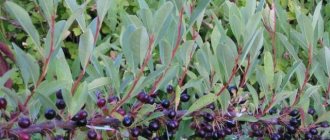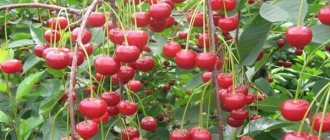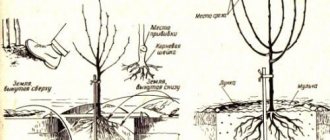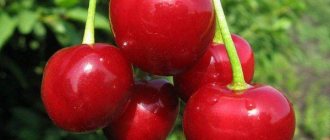Description of the bush
Steppe cherry grows in the form of a bush and reaches a height of no more than 2 m. On straight or slightly drooping green or brown branches grow small green leaves of an elongated shape, up to 8 cm long, located on short petioles of 1.5 cm. The crown resembles the ball can be flattened, its diameter is about 1 m.
The root system is well developed, the roots are long, reaching 1.5 m in depth and 8 m in width, about 0.5 m is on the surface.
Description of fruits
The tree bears fruit generously with edible fruits from pink to dark red, no more than 3 cm in diameter. The fruits are spherical, sometimes slightly elongated, covered with soft skin, weigh about 3 g each, and grow on thin stalks.
The pulp of the fruit is juicy, tastes sweet and sour, and inside there is a light, rounded seed about 5 mm in size. The fruits are used to make jam, jam, compote and are eaten fresh.
Main characteristics of the species
Those who have already planted this variety of cherry note its resistance to unfavorable temperature conditions and its ability to produce a rich harvest.
Winter hardiness
The shrub easily tolerates frosts down to -50 °C. Although its root system may be damaged during severe frosts, it quickly recovers. Swollen cherry buds can also survive frosts.
Drought resistance
Thanks to deep root growth, this cherry variety tolerates dry periods well when humidity drops to 20% and air temperatures exceed +40 °C.
Fruiting and productivity
For the first time, steppe cherries begin to bear fruit in the 4-5th year after planting; the fruits continue to ripen for 35 years. The ripening period occurs at the end of July. One bush can produce up to 11 kg of berries per season, and from 1 hectare you can harvest over 10 tons of cherries.
The most popular varieties of steppe cherries
The most popular varieties of steppe cherries are:
- “Bolotovskaya” - the fruits ripen late, are large, and have a dark color. Suitable for arid and frosty areas, the crown is lush. Young bushes bear fruit from the 3rd year of life. They do not require cross-pollination.
- “Desired” - the fruits are red, medium in size, ripen in mid-summer, blooms early, leaves have sharp tips, drooping branches, tolerates frost and drought well.
- “Shchedraya” is a tall bush, bears fruit well for 32 years, the fruits are dark in color, medium-sized, sweet, ripen at the end of summer, resistant to frost and drought.
- “Altai Swallow” is a medium-sized bush, needs annual pruning, is resistant to severe frosts, needs cross-pollination, the fruits are sweet, ripen in mid-summer, and are poorly stored.
- “Asha” is tall, with large fruits and a rich harvest, after planting it begins to bear fruit at 4 years of age, suitable for arid zones and regions with average frosts, and is almost not affected by fungi.
- “Maksimovskaya” - large red fruits ripen in mid-summer, slightly oval, triangular crown, several trunks, resistant to frost and drought.
- “Irtyshskaya” - has special winter hardiness, but does not tolerate drought well, needs cross-pollination, the fruits are tasteless, more suitable for preservation than for fresh consumption.
- “Subbotinskaya” is a tall bush up to 2.5 m in height with a dense crown, often affected by fungus and needs regular pruning, produces sweet large fruits, resistance to drought and frost is average.
Growing conditions
In order for the steppe cherry to bear fruit well and for a long time, you need to choose the right place for planting it. It should be well lit, without drafts, not low-lying, so that water does not stagnate there.
Read also: Best tips for caring for and planting cherries
The bush is not too picky about the soil, but it will be better if you plant it in non-acidic, loose, sand-rich soil.
Considering that most varieties require cross-pollination, make sure you have a few more cherries.
Optimal time and recommended planting pattern
The best time to plant steppe cherries is early April, when the snow has already melted. The soil is first dug up to a depth of 20 cm and fertilized with compost, manure, phosphate or potash fertilizers.
2 weeks before planting, dig holes of a size corresponding to the volume of the roots in a straightened state, taking into account a 10 cm drainage layer. The distance between them should not be less than 1.5 m. Sand and peat are poured into the bottom of the hole. After planting, the seedlings are watered abundantly and sprinkled with ash.
Key points in care
Steppe cherries do not require care, but without it the harvest will not be so rich, and the life of the bush may be shortened.
Watering
To prevent the roots from rotting, water an adult cherry tree 3 times:
- When it blooms.
- When the fruits set.
- When the fruits are ripe.
The amount of water per bush should not exceed 15 liters, otherwise overheating will occur.
Feeding
It is better to fertilize the bush in spring and autumn, when it is at rest. However, some gardeners recommend fertilizing after flowering. Organic matter, humus, ash, phosphate, potassium, and nitrogen fertilizers are suitable for feeding.
Soil care
The ground around the bush must be regularly loosened, freed from weeds, not allowing them to take away useful substances.
To keep the soil loose longer and weeds to grow worse, it is recommended to mulch with natural materials - dry leaves, sawdust, grass clippings, etc.
Pruning and shaping bushes
Proper pruning of the crown is the key to a good harvest, because there will be no harvest on the affected branches and young shoots. Pruning is carried out annually, starting from the first year of the bush’s life.
Basic rules for pruning and forming a bush:
- In autumn and early spring, it is necessary to cut off dried and affected shoots.
- To ensure the growth of side branches, the top of the bush is cut off.
- 5 thick branches are left below, located no less than 3 cm from each other.
- Small branches that form a dense crown need to be thinned out, otherwise they will cast a shadow and will not allow you to get a good harvest.
- Old branches are removed no earlier than after 8 years.
Advantages and disadvantages
Advantages of growing steppe cherries:
- Resistance to frost and drought.
- No need for careful maintenance of the bush.
- Not picky about soil.
- A bountiful harvest.
- Delicious fruits.
- Long lifespan.
- Ease of breeding and reproduction.
- Can be used for site decoration.
Negative aspects of growing a plant:
- The fruits ripen late and are poorly stored.
- The shrub begins to bear fruit no earlier than 4 years after planting.
- The crown must be trimmed regularly.
- Does not tolerate shadows.
- Needs cross-pollination.
- It is affected by pests, coccomycosis and clasterosporiosis.
Thus, by planting steppe cherries on your plot, you will not only improve it, but will also be able to regularly receive a rich harvest. An important advantage is the plant’s undemanding nature and the ability to grow in frosty and dry regions. However, do not forget to trim the bush and treat it against pests and diseases.
FORMATION OF STEPPE CHERRY.
Most modern varieties of steppe cherries practically do not form basal shoots, so you don’t have to fight them. Caring for bushes is limited to sanitary pruning and removal of old and thickening branches.
There is no need to give the bushes any shape. This is a fruit plant, and the more berries it brings you, the better!
I recommend that all gardeners plant at least 3 steppe cherry bushes. This is especially true for those whose plots are located in the risky farming zone.
.
With good care, steppe cherries will annually produce high yields of tasty, sweet berries, unlike common cherries!
And one more piece of advice: buy planting material only from large, trusted companies, preferably after presenting a quality certificate. And at the market near the road, you will most likely be offered wild steppe cherries, which are only good for jam (and even then it’s not very tasty).
Description of the species
Appearance
Steppe cherry is a low-growing shrub. An adult bush has a height of 0.5-1.5 meters. Mainly propagated by root shoots, very rarely by cuttings. An adult plant has long branching roots, with numerous branching adventitious shoots. The distance between adjacent shoots on the root is approximately 70-90 cm. Young shoots are reddish-brown in color, elongated, monopodial in shape. Their above-ground part is covered with lanceolate, scale-like leaves, which die off during further growth of the shoot.
Mature trunks have dark gray bark. They are erect, branched, covered with scattered hairs during the period of active growth, and become bare over time. The foliage is oblong, 8-16 mm long, depending on the age of the shoot, it has a more rounded oval or lanceolate shape. The leaves are smooth, dark green, lighter below, pinnate. The distribution area extends from Northern Asia and Siberia to Western Europe. It is not uncommon in Italy, southern Germany and central Poland.
Flowering and fruits
Blooms profusely. The flowers are small, collected in 3-5 umbrella-shaped inflorescences or solitary, appear simultaneously with the leaves or before they bloom. Bush cherry in the garden looks attractive and picturesque, and has a low growth rate. It is a partially self-fertile variety, so other pollinating varieties should be planted nearby to obtain ovaries.
The berries of steppe cherries are, as a rule, small; in rare grafted varieties they are medium in size, dark red or red in color with a dense skin. They have a sweet-sour, watery taste. Bush cherry is very susceptible to fungal diseases, in particular coccomycosis. In the photo you can see the shape of the berries and leaves, the appearance of the bush in general.
Description of wild steppe cherry
Wild bush cherry grows in the steppe and forest-steppe zones of the European part of Russia, the North Caucasus, Western Siberia, Central Asia, and Central Europe. Mainly found on open dry slopes and in bush thickets. Deciduous shrub up to 1 m tall, often with a spreading crown.
The bark of old shoots is light brown, darkish, with yellow lenticels; in young shoots it is gray, transitioning to reddish-brown at the top. The leaves are elongated oval or obovate (5x2 cm), dark green above, pale green below, matte. The flowers are white, 1.4 cm in diameter, in sessile or short-stemmed umbellate inflorescences, less often solitary. There are 2–6 flowers in the inflorescence.
According to the description, the fruits of steppe cherries are similar to other types of cherries: they are spherical drupes with a juicy pericarp, on a long thin stalk.
As you can see in the photo, the color of bush cherries varies from yellow with blush to dark cherry, almost black:
The size of the fruit varies greatly depending on growing conditions. The taste ranges from acidic, almost inedible, to sweet and sour, pleasant.
It grows from the beginning of the third ten days of April, blooms in the third ten days of May, the fruits ripen in early August, by the end of September the leaves turn bright yellow. Fruits from 3–4 years of age. Shoots do not always become lignified completely; for this reason, their tips sometimes freeze. Seed germination lasts up to 2 years, seeding rate is 10–15 g, planting depth is 4–6 cm. The life span of the shrub is 15–20 years, it renews itself well. Honey plant.
Undemanding to soil, drought-resistant, light-loving, little damaged by pests and diseases. Thanks to its abundant root shoots, it is suitable for securing dry slopes, landscaping rocky areas, group plantings, landscaping edges, and borders. I. V. Michurin obtained such varieties as Ideal, Volevka, Fertile, Pioneer and others. Recently, since Shrubby plant breeders from Siberia are working. New varieties: Dessertnaya, Arena, Bouquetnokistevaya.
Varieties
For the convenience of gardeners, below is a description of the most common varieties of steppe cherries.
Generous
The height of the bush reaches 2.3 meters, has a wide, spreading shape with shoots raised upward, of medium foliage. The leaves are elongated, shiny, dark green. There are 3-4 flowers in the inflorescence, the corolla is open in diameter 20 mm. Fruits on annual growth and bouquet branches. The berries are medium large, weighing 3-4 g, dark red in color, resistant to cracking. They have a sweet, watery taste. The detachment from the stalk is dry.
Refers to self-fertile varieties. The flowering period is in the middle, May 18-25. The fruits ripen late, at the same time, in the second half of August. It begins to bear fruit at 3-4 years of age. Productivity is high, annual. Taking into account regular anti-aging pruning and proper feeding, this variety is relatively durable - up to 32 years. It has high winter hardiness and drought resistance. Flowers and buds are resistant to spring frosts.
Bolotovskaya
Widely round, spreading bush up to 1.7 m tall. The leaves are glossy bright green, elongated, oval in shape. 4 flowers in an inflorescence. The fruits are large, 4-4.5 g, round, dark red in color. The pulp is medium density, red, juicy, sweet and sour. The berries are resistant to cracking.
Refers to highly self-fertile varieties. The period of flowering and fruit ripening is mid-late. The berries ripen in the first part of August. It bears fruit from 2-3 years, with proper and timely care for more than 30 years in one place. Drought resistant. Winter-hardy. Susceptible to fungal diseases. Productivity is high.
Ashinskaya
Tree-like, fast-growing, up to 2.2-2.7 m high. The crown is conical, medium thick. The leaf is dark green, oblong, rounded, narrowly oval, curved upward, the petiole is short. The flowers are small, 5-6 in an inflorescence, the peduncle is short. The fruits are large, weighing 4-4.5 g, dark red juicy, thick skin. Resistant to cracking. The taste is sweet and sour. They ripen late, in early August. The variety is partially self-fertile. The flowering period is medium, extended. It bears fruit for 4-5 years, up to 30 years in one place. Average frost resistance. High resistance to fungal diseases. Drought resistant. Productivity is high, annual.
Maksimovskaya
Maksimovskaya cherry, like Irtyshskaya, has a multi-stemmed bush, up to 1.5-1.8 m high. The crown is medium thick, pyramidal. The branches are light brown, spreading, smooth. The leaves are shiny, light green, short-pointed, round, oblong. The flowering period is average. The berries are large, red, oblong-round, on long stalks. Ripen in mid-July. They have a sweet-sour taste and are juicy. The annual yield is high. Drought resistance and winter hardiness are high. Propagated by cuttings, produces few root shoots.
Desired
The bush is medium-sized, up to 1.5-1.7 m high. The crown is medium-thick, wide, raised. The shoots and branches are brown, covered with small lenticels and a gray coating, drooping. The leaves are elongated, pointed, light green in color, short petiole.
The flowering period is early. The berries are medium-sized 3-3.4 g, dark red or red in color, ripen in the second half of July. Productivity is high, annual. Fruiting begins at 2-3 years. Drought resistance and winter hardiness are high. This variety is resistant to damping off. It produces few root shoots and propagates by cuttings.
Description of bush steppe cherry varieties
Steppe cherry is a hybrid that was obtained by crossing bush and garden cherries.
If you decide to plant this particular variety of berry on your plot, first you should read the description, namely, understand the characteristics of this variety, in what conditions it grows best, and what soil is most favorable for it .
In addition, it is worth remembering several important features of caring for this plant, but still, first things first. First of all, it’s worth finding out what kind of species it is and what qualities it has.
Steppe cherry
in the state international register at the beginning of 2002 . This variety of cherry is a successful hybrid between bush and common type cherries.
The originator of this species is the South Ural Research Institute for Vegetable and Potato Growing.
The authors-scientists who worked on breeding this species are Anastasia Efimovna Pankratova, Kabir Kadirovich Mullayanov, Vladimir Ilyich Putyagin, I.G. Zamyatina.
Regions of growth
This bush type of cherry is widespread throughout all regions of Russia and the CIS countries. Steppe cherry grows in the areas:
- In the Ural region;
- In the Caucasus;
- In Kuban;
- In the Volga region;
- In the Nizhny Novgorod region;
- In the Rostov region;
- In the Voronezh region;
- In the Yaroslavl region.
This type of cherry is also often found in Asia Minor and Central Europe.
Steppe cherry trees have the following characteristics:
- Varieties of this type have slender trees , there is no crown connection;
- The height of the tree is from 2.6 to 3.2 meters;
- The size of the trunk is approximately 20-45 centimeters;
- The crown is strong and dense . The crown shape is cylindrical and elongated;
- a large number of leaves on the crowns ;
- The shoots have oval, slightly rounded shapes; they may have a small amount of fluff;
Tree Steppe cherry
- The color of the shoots is brown-gray with a silver color;
- The length of the shoots can reach up to 30-45 cm;
- Lentils are of medium size and are found in small quantities;
- The kidney has a bent state , is quite long, and is of medium size. Smooth and even to the touch;
- The foliage on the trees has a dark, rich green hue;
- The shape of the leaves is round , slightly narrowed, oblong, and has a slight upward bend;
- The length on average can reach up to 8 cm, and the width can reach up to 4 cm.
Fruit quality
The steppe cherry berry has a number of characteristics:
- The shape of the berries is oval with slightly rounded edges;
- The weight of mature fruits ranges from 4.2 grams to 5 grams;
- The color of ripe fruits is dark burgundy, the inside structure of the pulp has a burgundy tint with bright red juice;
Cherry fruits Stepnaya
- The skin of the cherries is shiny, quite dense, but soft;
- The stalk has a retracted shape with a length of about 4 cm;
- The shape of the stalk is straight, oblique with a fine structure.
Many gardeners call steppe cherry varieties dessert, but despite this, they belong to the universal types.
They are used to prepare various mousses, jams, jams, compotes, and concentrated juices. In addition, decoctions of berries are often used in gastroenterology and for feverish conditions.
Due to the high content of cobalt, nickel, copper, iron, it improves hematopoiesis and overall well-being.
Inside the fruit there is a round stone with a cream color. The size of the stone thickness is about 0.4 cm. The length of the stone can be about 0.6 cm, width - 0.5 cm.
The seed easily comes away from the berry pulp and has a smooth surface, so when consumed it does not cause cuts or damage to the mouth. The average weight of a seed is about 0.17-0.20 grams.
Pollination
Cherry varieties of the steppe type are considered self-fertile. They exhibit partial self-pollination. Therefore, when planting steppe-type cherry varieties, you don’t have to plant pollinators nearby ; it will grow quietly and produce crops without pollinators.
Bloom
Steppe cherry in bloom
The duration of flowering is average, quite extended in time. Flowering is usually observed on May 20-31. During this period, flowers appear on trees that have the following characteristics:
- The flowers are small in size, they are located on a short stalk;
- One inflorescence can have about 5-6 flowers;
- All petals are located spaciously, at a decent distance from each other;
- The shape of the petals is oval with a wide forked upper part;
- The top of the calyx is widened, bell-shaped, and slightly serrated;
- The corolla is made in the form of an oval-saucer shape;
- The stamens are located above the stigma of the pistil, their number can reach up to 26 pieces.
Productivity
Steppe-type cherries have a stable yield level. The trees produce high yields every year.
Steppe cherry produces a high yield every year
The fruits have late ripening periods. Full ripening of the berries occurs around the beginning of August . The berries ripen at the same time. With increased rainfall, the berries may crack.
Full fruiting occurs 4-5 years after planting the seedlings. One tree can bear fruit well for 35 years .
It is worth noting that on average you can collect from 8 to 11 kilograms of ripe berries from one plant. Almost 10-12 tons of berries can be collected from one hectare.
Cherry trees of the steppe type tolerate severe frosts well. Plants can easily tolerate frosts down to -48 degrees Celsius.
Fruitful buds can withstand average frosts in winter, almost the same as trees down to -45-48 degrees Celsius. Inflorescences and buds have slightly above average frost resistance.
But as for the root system, its frost resistance is assessed on a three-point scale. In addition, after freezing, the roots quickly restore their structure.
The advantages of steppe cherries include the following qualities:
- High yield . From one tree you can collect almost 12 kilograms of ripe berries;
- Resistance to drought and frost;
- Annual fruiting ;
- Long lifespan of trees, almost 35 years;
- Large berry of the same size;
- High resistance to diseases ;
- Reproduction can occur in a variety of ways;
- Ripe fruits have excellent taste . In addition, they have a high level of useful components that are useful for the full functioning of the digestive system, and they also improve the state of human hematopoiesis;
Steppe cherry berries are widely used in cooking
- Ripe berries can be used to make juices, preserves, jams, compotes, marmalade and other winter preparations.
However, there are also negative qualities:
- Late ripening , at the beginning of the last month of summer;
Unripe steppe cherry
- Fruiting occurs only 2-4 years after planting the seedlings;
- The soft structure of ripe fruits is often damaged by precipitation and during transportation.
To begin with, it is worth highlighting the main methods of propagation of steppe cherries:
- Using cuttings;
- Due to growth;
- Bones;
- With the help of vaccination.
Cherry grafting by bark
At the beginning of June it is necessary to prepare the shoots . It is important that they have a reddish tint, with a slight hardening at the base.
The length of the prepared shoots should be more than 30 cm. Circumcision should be done in the evening or early in the morning. The weather should be cool. After the stems are cut, they need to be placed in water . In order to speed up the process of root system emergence, it is advisable to use special chemical growth regulators.
Heteroauxin can be used as a growth regulator . 100 ml of this product is diluted with water and ethyl alcohol. Then you need to tie up the cuttings and lower them into 1 liter of this solution. The cuttings should be kept in this mixture for 18 hours.
The planting process has certain nuances that should be strictly adhered to:
- You should dig up the soil , remove all weeds and unnecessary plants, and form beds;
- All excavations should be filled with peat and sand , the layer size should be about 10 cm;
- Next, river sand is poured on top , everything is loosened, leveled and compacted;
- After this, the earth is watered abundantly and fed with superphosphate;
- Cuttings should be planted in a vertical position , the distance between trees should be at least 7 cm;
- It should be planted no more than 3 cm deep ;
- After this, all seedlings are covered with a plastic bag ;
- In the future, it is worth ensuring good watering .
During intensive growth, adequate watering should be provided. It is carried out 2-3 times. For each watering one tree will need about 3-5 buckets .
The first watering is done immediately after flowering, additional fertilizing is applied, the second is done immediately after fruit set, the third during the ripening of the berries.
Before flowering begins, organic and mineral fertilizers are applied, then they are applied after flowering and at the time of fruit set.
To ensure that the choice does not cause difficulties, it is still worth knowing which varieties belong to the steppe cherry. Below we consider the most popular varieties:
- Generous . It has a high yield; up to 11 kilograms can be harvested from one tree. Flowering period from May 18-25. Fruiting occurs from 3-4 years of life after planting. It has high drought and frost resistance. Life expectancy 32 years;
- Bolotovskaya . High-yielding late variety. It begins to bear fruit 2-3 years after planting. Life expectancy up to 30 years;
- Ashinskaya . High-yielding late variety. Fruiting begins in early August. It begins to bear fruit at 4-5 years of age after planting. Lifespan 30-32 years;
- Maksimovskaya . High-yielding variety with late fruiting. Fruit ripening begins in early August. Young trees begin to bear fruit only 3-4 years after they are planted. The average lifespan of trees is about 30-35 years.
Cherry steppe Ashinskaya Cherry steppe Bolotovskaya Cherry steppe Maksimovskaya Cherry steppe Generous
Steppe-type varieties have increased resistance to various diseases and pests. Trees are practically not susceptible to a fungal type of disease - coccomycosis . And also other types of fungal infections were not observed in steppe-type cherries.
In addition, no damage by insects, pests and other diseases to the varieties of steppe cherries, as well as to the felt ones, was detected.
Steppe cherry has good qualities for which it is valued by many summer residents and gardeners.
It has good yields, is frost-resistant and is practically not susceptible to diseases . And her harvests are always pleasing every year and in large quantities.
But still, in order to obtain the desired result, the varieties of this plant must be looked after - watered, fertilized, and digging of the earth near the trunk in autumn and spring. This is the only way to grow cherries, the harvests of which will delight you every year.
Source: https://profermu.com/sad/derevia/vishnia/sorta-v/stepnaya.html
Features of cultivation
Planting and fertilization
Planting and care consists, first of all, in the right choice of location. Steppe cherry bears fruit poorly and often turns white in a shaded area; a sunny place is chosen for it, where in winter the snow level does not exceed 70-90 cm, since part of the bark in the root zone can support the snow when it melts. You can reduce the risk of damping off by planting cherries on small mounds or ridges. This variety is not picky about the soil, but you should give preference to medium and light sandy loam.
Before planting, be sure to add humus 4-5 kg per m2, potassium and phosphorus fertilizers to the depth of the roots, dissolving them in 15-20 liters of water. This will allow you to get greater yields in a short time next year. Steppe cherries are planted in early spring, when the soil thaws and warm, constant weather sets in. During the growing season, feeding with superphosphates is mandatory. During the period of intensive growth, 2-3 abundant waterings should be carried out, in the amount of 3-5 buckets for each bush. The first watering is carried out immediately after flowering, combining it with fertilizing, the second - after fruit set, during their ripening.
Chemical treatment and pruning
Since steppe cherries mainly bear fruit on annual branches, a decrease in its growth leads to a significant decrease in yield and smaller fruits. With regular, timely pruning, cherries can bear fruit abundantly in one place for 18-20 years. The bush is thinned out, leaving no more than 8-14 branches with developed lateral branches. It is necessary to remove damaged, dried branches - the source of reproduction and overwintering of the disease. To increase the yield and quality of berries, remove excess root shoots and branches older than 7-8 years, under the ring. 3-4 basal branches should be left annually. Do not shorten annual shoots under any circumstances.
Since steppe cherries have a high tendency to fungal diseases, for prevention during the flowering period, a mandatory first spraying with special preparations is carried out. And repeat 2-3 treatments every 7-10 days.
Video “Bush or steppe cherry”
This video highlights the features of fruiting, care and planting of this variety.
Watering and fertilizers are the key to a good harvest
During intensive growth, adequate watering should be provided. It is carried out 2-3 times. For each watering one tree will need about 3-5 buckets . The first watering is done immediately after flowering, additional fertilizing is applied, the second is done immediately after fruit set, the third during the ripening of the berries. Before flowering begins, organic and mineral fertilizers are applied, then they are applied after flowering and at the time of fruit set.
Steppe or bush cherry: photo and description
Russian gardeners fell in love with steppe cherries due to their good tolerance to drought and resistance to strong winds and cold. The variety is easy to care for and is not particularly demanding on the soil.
The steppe cherry (shrub) is presumably one of the ancestors of the modern common cherry. This species is found in the wild in Western and Eastern Europe, Kazakhstan and western Siberia. Cultivated selection is widespread from St. Petersburg to Baikal.
AMAZING TRANSFORMATIONS OF STEPPE CHERRY
Most gardeners believe that common cherries are an independent stone fruit crop.
However, it is not! Common cherry is a hybrid that resulted from the accidental cross-pollination of steppe cherry and wild cherry
approximately 20 centuries ago. That is why there are no natural thickets of common cherry in nature.
And if there are similar plantings somewhere, then these are abandoned, degenerate gardens of once cultivated plantings. But the steppe cherry, which we will talk about today, grows in nature.
EVERYTHING YOU NEED FOR THIS ARTICLE IS HERE >>>
Steppe cherry photo and description
This variety of cherry grows in the form of a dense bush from 0.5 to 2 meters in height. The crown is flattened and rounded or spherical, the branches are drooping or erect. Leaves have short petioles, oval shape, leathery and small.
Flowering begins in late spring. Flowers with a corolla and white open petals, collected in umbrellas of 3-4 pieces. The plant is self-sterile and requires cross-pollination. Therefore, it is recommended to plant at least three varieties of cherries on the site for cross-pollination.
The weight of the berries ranges from 1 to 3 g, the shape is round, the color is pink or dark red, the taste is sour or sweet and sour, the seeds are small. Ripening occurs at the end of July - beginning of August. A plant grown from seedlings bears fruit in 4-6 years, and grafted and self-rooted plants bear fruit in 3-4 years.
The root system grows horizontally about 20–60 cm from the surface, 5–8 meters long and vertically to a depth of one and a half meters, making the bush resistant to drought and high humidity. The bushes are surrounded by growth of different ages. The placement of roots and shoots should be taken into account when cultivating and fertilizing the soil.
Description of the variety Stepnaya Ashinskaya
Features of steppe bush cherry
Steppe cherry comes from the plum genus. It is a forest-steppe plant. Does well in temperate continental climates .
In rural areas it is preserved along the edges of pine forests, clearings, gullies, dry slopes and ravines.
Currently, various agricultural works are underway: plowing land, landscaping, construction and cattle breeding.
Therefore, the steppe cherry does not have the opportunity to capture new territories.
Reproduces remarkably well by shoots. It is a low-growing shrub, reaching a height of up to one and a half meters. Most often 0.6-1.1 meters. It has thin, slightly raised shoots with small compressed and dense leaves of an elliptical shape.
Cherries are varied in shape, sour in taste with pronounced astringency . Often eaten by steppe inhabitants. The berries vary in shade intensities - from bright red to dark burgundy. The stone inside the pulp is very sharp and small at both ends.
Cherry is early fruiting. It can begin bearing fruit in the second or third year. Steppe cherry is a winter-hardy variety. Withstands severe winter frosts from 47 to 55 degrees Celsius. It grows where ordinary cherries cannot take root. Has a high index of drought resistance. The tree can live from 20 to 25 years.
A bush cherry may have several main trunks that extend from a short trunk or from the root system.
Therefore, such cherries are found in the form of overgrown dense thickets. The tree has bare shoots with small leaves.
They are bright green in color, lanceolate in shape, and shiny. The flowers are white or beige, collected in three or four false umbels.
The length of the peduncle does not exceed 25 millimeters. The flowering period occurs at the end of April.
Cherry does not require mandatory agrotechnical measures. The death of a tree may be accompanied by a decline in yield, cessation of growth, and drying out of the crown and skeletal branches.
With a small number of fruiting buds, the death of the tree occurs many times faster. Can be used as an ornamental plant. Today it is very rare. Listed in the Red Book.
Differences between steppe bush cherry and ordinary garden cherry
- Steppe cherry has cherries of different characteristics and shapes . The garden cherry has an oval berry with rounded edges.
- The steppe cherry has a sour berry, with pronounced astringency . Garden cherries have a milder taste. The fruits are sweet, with a slight sourness.
- Bush cherries have fruits of varying color intensities - from bright red to dark burgundy. The common cherry has an even hue, mostly dark red.
The bush cherry stone is pointed at both ends and very small. The garden one is round with a creamy tint, 0.4 centimeters thick. The ribs of the bone are smoothed and do not cause cuts in the mouth.
- The steppe cherry begins to bear fruit in the second or third year. Garden cherries bear fruit 4 or 5 years after planting the cuttings.
- Steppe cherry is a winter-hardy variety. Withstands severe winter frosts from 47 to 55 degrees Celsius. Garden cherries have average frost resistance , up to minus 48 degrees Celsius.
- Steppe cherry trees are preserved along forest edges, gullies and ravines. Sadovaya takes root well in personal plots, in the orchards of amateur gardeners, industrial and collective gardens.
- The prairie cherry tree can live 20 to 25 years . Garden cherry tree - up to 35 years.
- A bush cherry may have several main trunks that extend from a root system or a small trunk. Garden cherry has one main trunk.
- The flowering period of steppe cherries occurs at the end of April. Garden cherry blossoms occur at the end of May.
- The steppe tree has small leaves. Garden cherry leaves are even 2-3 times smaller.
Bush cherry: planting and care features
For steppe cherries, the planting location is important. Shaded areas and improper care can cause poor harvests and frequent diseases.
Landing
For planting, a sunny, elevated place is suitable, where in winter the snow cover will not exceed 90 cm, which will avoid the roots becoming warm when the snow melts.
In early spring, after the snow melts and warm weather sets in, cherries can be planted. To increase and accelerate the yield when planting, humus (at the rate of 4-5 kg per sq.m.), potassium (20 - 25 grams) and phosphorus (40 - 50 grams) fertilizers, previously dissolved in 15-20 liters, is added to the bottom of the hole. water.
During the period of intensive growth, it is necessary to fertilize with superphosphates, add wood ash and other mineral additives, which will contribute to intensive growth and fertility. In summer you need to loosen the soil and get rid of weeds.
It is enough to moisten the bush 2-3 times a season, using 30-50 liters of water. The first watering is carried out after flowering, the second - during the formation of fruits, the third - when they ripen. After harvesting, it is not recommended to flood the plant, so as not to provoke rotting during the autumn and winter.
Rules for growing steppe cherries Zhelannaya
For favorable cultivation of crops, weeding and shallow loosening of the soil are necessary.
Proper pruning of cherries increases the yield
The agricultural technology of the crop also includes periodic watering, fertilizing and thinning pruning of shoots.
Watering and fertilizing schedule
For additional watering of cherry bushes, the drip method is most suitable, as fungal infections are less likely to occur. Depending on environmental conditions, up to four additional heavy waterings may be required. Particularly important periods are flowering and the beginning of fruiting.
Advice! Watering cherries is stopped a month before harvest.
After planting in a well-filled hole, the next fertilizing is applied in the year of the first fruiting. Fertilizers are used at the rate of: 100 g of superphosphate and 1-2 kg of ash per bush. The components are applied along its perimeter at the end of summer after picking the berries. Compost is added in early spring or late autumn. Once every 5-6 years, the soil under the bushes is deoxidized with dolomite flour.
Trimming
Pruning is carried out in April along dormant buds. It consists of forming a crown and removing damaged shoots. Thickening branches are also cut out so that all fruits have enough light. An indicator of the correct development of the crop is the annual growth of shoots of 30-40 cm. Excessive, as well as insignificant, growth of branches has a bad effect on the yield and winter hardiness of the crop.
Preparing for winter
The bush-shaped shoots of the Zhelannaya cherry are flexible, which allows them to be freely bent and covered in preparation for the winter period. Unprotected branches, like fruit buds, can be significantly damaged in harsh winters.
Rules for pruning bush cherries
An important point in caring for bush cherries is pruning the branches, which is carried out in the autumn and spring months. Thanks to it, you can correctly form the crown, which will facilitate harvesting and expand access when caring for the plant.
When pruning bush cherries, you need to know that berries appear only on last year's shoots. The flowers, grouped into inflorescences, appear along the entire length of the annual branch from the buds.
A year after planting, it is recommended to carry out annual sanitary (withered and weak branches are removed with pruners) and formative pruning (the bush is given the desired shape). Regular and timely removal of unnecessary shoots will strengthen the plant, extend the fruiting time and have a positive effect on the size and quality of the berries.
Pruning steppe cherry:
- In spring and autumn, dry and damaged branches must be cut off.
- To rejuvenate the bush and when creating a shape, shorten the branches. For the Russian climate, a bush or low-standard crown is appropriate. Therefore, the top of the plant is cut off to encourage the formation of new shoots at the bottom of the bush. In the lower part, the location of the branches should be at a distance of 3 to 8 centimeters, the remaining shoots are cut off.
- To form a spreading and multi-stemmed crown, at least five branches are left. Then they simply thin out the internal shoots, preventing the bush from thickening.
- After about seven years, when the trunks of the bush begin to age and the length of the shoots becomes shorter, rejuvenation is carried out by cutting out the old trunks and growing new ones from the root shoots.
- You can rejuvenate steppe cherries with stem shoots that grow from adventitious buds located on underground stems. They bear a lot of fruit and make an excellent replacement for cut crowns.
Advantages and disadvantages of steppe cherries
Benefits of bush cherries include:
- excellent frost resistance of the plant. But this does not apply to young growth, which is not particularly resistant to frost, and therefore requires shelter for the winter with agrofibre or burlap;
- thanks to its specific root system, it is drought-resistant;
- unpretentiousness to the soil. Gives a good harvest, growing on rocky, poor soil;
- the berries are tasty, well suited for preparations: compotes, juices, jam;
- It is also used for decorative purposes, thanks to its early and abundant flowering and richly colored fruits, it becomes a magnificent garden decoration.
The disadvantages of bush cherries include:
- lack of shade tolerance;
- the taste of the berries is characterized as more tart and sour than that of ordinary cherries;
- susceptibility to attack by pests, coccomycosis and clasterosporiasis;
- self-sterility of the plant.
Thanks to its taste, unpretentiousness, resistance to frost and drought, steppe cherries will become indispensable in your summer cottage. Proper care of this plant will allow you to enjoy the beauty of its flowering for a long time and harvest an excellent harvest of berries.
STEPPE CHERRY – VIDEO
Steppe cherry
© Author: O. IVANOVA, experienced gardener, Moscow region
ORDER QUALITY AND CHEAP SEEDS AND OTHER GOODS FOR YOUR HOME AND GARDEN. PRICES ARE PRICEY. CHECKED! JUST LOOK FOR YOURSELF AND BE SURPRISED. THERE ARE REVIEWS. GO>>>
Below are other entries on the topic “Do-it-yourself cottage and garden”
- Cherries and sweet cherries in Siberia - expert reviews of the best varieties: SIBERIAN CHERRY AND CHERRY What we...
- Growing felt cherries in Karelia - planting varieties and care: Planting and caring for felt…
- Garden secrets and tips – issue 1: Secrets and tips from summer residents Fresh...
- Planting felt cherries - tips: How best to plant felt cherries About...
- Cherry variety Kalitvyanka (Torch) my reviews on growing: CHERRY TORCH - KALITVYANKA -...
- How to propagate cherries by shoots: Propagation of cherries by shoots Cherry is a culture...
- The best varieties of cherries - name and description (Penza region): MY REVIEWS ABOUT CHERRY VARIETIES...
Subscribe to updates in our groups and share.
